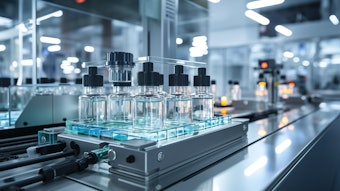
PH is critical for many biological processes. Most enzymatic reactions are pH dependent. Consequently, pH is highly regulated by different organs, tissues or even cells within very specific and often very narrow pH ranges.
The skin’s surface pH is acidic, which is important for many processes involved in the synthesis and maintenance of the skin barrier.1-3 For example, two enzymes, acidic sphingomyelinase and β-glucocerebrosidase, that are involved in ceramide formation have an optimal pH of ~5.4, 5
The skin’s acidic pH is also involved in the regulation of stratum corneum desquamation, and it keeps proteolytic enzymes in check. Conversely, elevated pH levels result in the rapid degradation of corneodesmosomes and consequently, in compromised stratum corneum integrity.6
The present article briefly explores the natural pH level of healthy skin and considers the implications on skin health as these levels fluctuate. Factors considered include the skin microbiome, topical products, acidification of the skin surface, buffering capacity and locking in the optimal pH.
Natural pH of Skin
Determining the optimal or natural skin surface pH is a difficult task, as skin is exposed to an external environment that constantly challenges skin and its pH. Skin pH also slightly varies with age, body location, ethnicity or even circadian rhythms.7-9 Most numbers given as the natural skin surface pH come from pH averages of the distributions measured in different studies.
Since most factors that can affect skin pH, such as water, soaps, detergents, cosmetics or even sweat, tend to increase the surface pH, the reported averages measured in many studies may be skewed toward higher pH values. Therefore, the optimal pH range of skin likely lies somewhere between 4.5 and 5. In a recent study, the authors introduced a 24-hr washout period without water contact or any cosmetic products and concluded the natural skin surface pH is likely around 4.7.10
Read more in the October edition of C&T magazine
References
- Ohman, H. and Vahlquist, A. (1998 Oct). The pH gradient over the stratum corneum differs in X-linked recessive and autosomal dominant ichthyosis: A clue to the molecular origin of the ‘acid skin mantle’? J Invest Dermatol 111(4) pp 674-677; doi: 10.1046/j.1523-1747.1998.00356.x
- Proksch, E., Jensen, J.-M. and Elias, P.M. (2003). Skin lipids and epidermal differentiation in atopic dermatitis. Clin Dermatol 21(2) pp 134-144; doi: 10.1016/s0738-081x(02)00370-x
- Elias, P.M. (2015, Mar). Stratum corneum acidification: How and why? Exp Dermatol 24(3) pp 179-180; doi: 10.1111/exd.12596
- Takagi, Y., Kriehuber, E., Imokawa, G., Elias, P.M. and Holleran, W.M. (1999). β-Glucocerebrosidase activity in mammalian stratum corneum. J Lipid Res 40(5) pp 861-869; doi: https://doi.org/10.1016/S0022-2275(20)32121-0
- Ali, S.M. and Yosipovitch, G. (2013). Skin pH: From basic science to basic skin care. Acta Derm Venereol 93(3) pp 261-267; doi: 10.2340/00015555-1531
- Mauro, T., et al. (1998 Apr). Barrier recovery is impeded at neutral pH, independent of ionic effects: Implications for extracellular lipid processing. Arch Dermatol Res 290(4) pp 215-222; doi: 10.1007/s004030050293
- Marrakchi, S. and Maibach, H.I. (2007 Jul). Biophysical parameters of skin: Map of human face, regional and age-related differences. Contact Derm 57(1) pp 28-34; doi: 10.1111/j.1600-0536.2007.01138.x
- Blaak, J., Wohlfart, R. and Schürer, N.Y. (2011). Treatment of aged skin with a pH 4 skin care product normalizes increased skin surface pH and improves barrier function: Results of a pilot study. J Cosmet Dermatol Sci Appl 1(3) pp 50-58; doi: 10.4236/jcdsa.2011.13009
- Yosipovitch, G., Xiong, G.L., Haus, E., Sackett-Lundeen, L., Ashkenazi, I. and Maibach, H.I. (1998 Jan). Time-dependent variations of the skin barrier function in humans: Transepidermal water loss, stratum corneum hydration, skin surface pH and skin temperature. J Invest Dermatol 110(1) pp 20-23; doi: 10.1046/j.1523-1747.1998.00069.x
- Lambers, H., Piessens, S., Bloem, A., Pronk, H. and Finkel, P. (2006 Oct). Natural skin surface pH is on average below 5, which is beneficial for its resident flora. Int J Cosmet Sci 28(5) pp 359-370; doi: 10.1111/j.1467-2494.2006.00344.x











